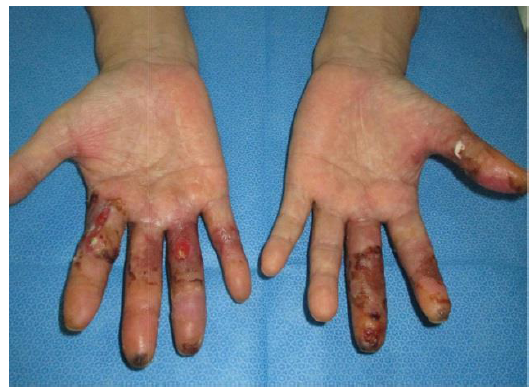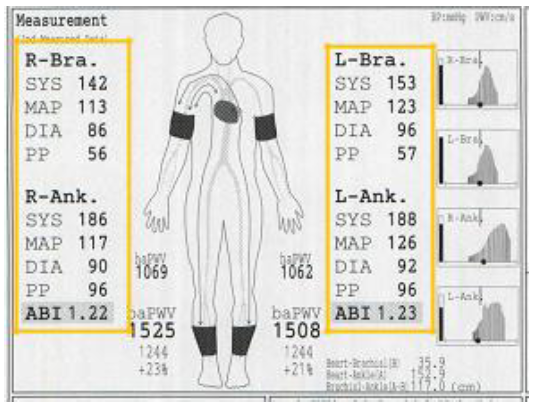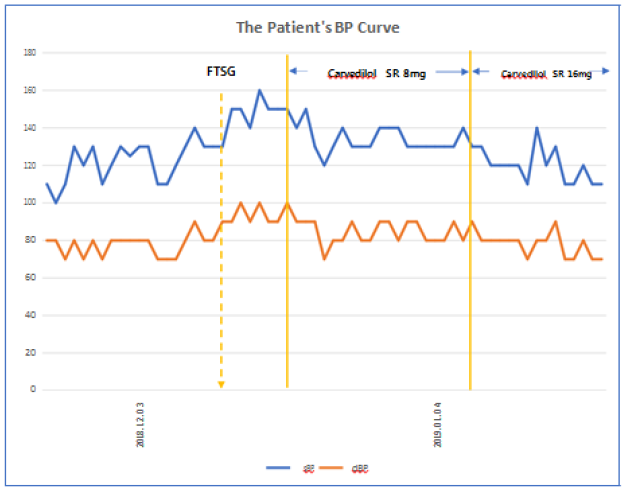Beta-Blocker Therapy for New-Onset Hypertension Following an Electrical Injury: A Case Report
Article Information
Ho-Dong Yang BS1, Donghoon Han MD1*, Dong Geum Shin MD1, Min-Kyung Kang MD. PhD1, Jung Rae Cho MD, PhD1, Seonghoon Choi MD1, Jong-Wook Lee MD2, Namho Lee, MD, PhD1
1Department of Internal Medicine, Cardiovascular Center, Kangnam Sacred Heart Hospital, Hallym University College of Medicine, Seoul, Korea
2Department of Plastic Surgery, Burn Center, Hangang Sacred Heart Hospital, Hallym University College of Medicine, Seoul, Korea
*Corresponding Author: Dr. Donghoon Han MD, Clinical Associate Professor of Internal Medicine, Department of Internal Medicine, Cardiovascular Center, Hallym University, Kangnam Sacred Heart Hospital, Singil-ro, Yeongdeungpo-gu, 07441, Seoul, Korea
Received: 11 March 2020; Accepted: 20 March 2020; Published: 27 April 2020
Citation: Ho-Dong Yang, Donghoon Han, Dong Geum Shin, Min-Kyung Kang, Jung Rae Cho, Seonghoon Choi, Jong-Wook Lee, Namho Lee. Beta-Blocker Therapy for New-Onset Hypertension Following an Electrical Injury: A Case Report. Archives of Clinical and Medical Case Reports 4 (2020): 307-311.
View / Download Pdf Share at FacebookAbstract
Electrical injuries may occur in both home and workplace environments leading to cardiovascular complications, such as tachyarrhythmia, bradyarrhythmia, atrial fibrillation and myocardial injury. However, reports on electrical injury induced hypertension are rare. The choice of appropriate antihypertensive agents is therefore unclear. As described in this report, beta-blockers may be useful in hypertension induced by electrical injuries.
Keywords
Electrical injury; Hypertension; Beta-blocker; Cardiovascular complications; Skin graft
Electrical injury articles, Hypertension articles, Beta-blocker articles, Cardiovascular complications articles, Skin graft articles
Electrical injury articles Electrical injury Research articles Electrical injury review articles Electrical injury PubMed articles Electrical injury PubMed Central articles Electrical injury 2023 articles Electrical injury 2024 articles Electrical injury Scopus articles Electrical injury impact factor journals Electrical injury Scopus journals Electrical injury PubMed journals Electrical injury medical journals Electrical injury free journals Electrical injury best journals Electrical injury top journals Electrical injury free medical journals Electrical injury famous journals Electrical injury Google Scholar indexed journals injury articles injury Research articles injury review articles injury PubMed articles injury PubMed Central articles injury 2023 articles injury 2024 articles injury Scopus articles injury impact factor journals injury Scopus journals injury PubMed journals injury medical journals injury free journals injury best journals injury top journals injury free medical journals injury famous journals injury Google Scholar indexed journals Hypertension articles Hypertension Research articles Hypertension review articles Hypertension PubMed articles Hypertension PubMed Central articles Hypertension 2023 articles Hypertension 2024 articles Hypertension Scopus articles Hypertension impact factor journals Hypertension Scopus journals Hypertension PubMed journals Hypertension medical journals Hypertension free journals Hypertension best journals Hypertension top journals Hypertension free medical journals Hypertension famous journals Hypertension Google Scholar indexed journals Beta-blocker articles Beta-blocker Research articles Beta-blocker review articles Beta-blocker PubMed articles Beta-blocker PubMed Central articles Beta-blocker 2023 articles Beta-blocker 2024 articles Beta-blocker Scopus articles Beta-blocker impact factor journals Beta-blocker Scopus journals Beta-blocker PubMed journals Beta-blocker medical journals Beta-blocker free journals Beta-blocker best journals Beta-blocker top journals Beta-blocker free medical journals Beta-blocker famous journals Beta-blocker Google Scholar indexed journals Cardiovascular complications articles Cardiovascular complications Research articles Cardiovascular complications review articles Cardiovascular complications PubMed articles Cardiovascular complications PubMed Central articles Cardiovascular complications 2023 articles Cardiovascular complications 2024 articles Cardiovascular complications Scopus articles Cardiovascular complications impact factor journals Cardiovascular complications Scopus journals Cardiovascular complications PubMed journals Cardiovascular complications medical journals Cardiovascular complications free journals Cardiovascular complications best journals Cardiovascular complications top journals Cardiovascular complications free medical journals Cardiovascular complications famous journals Cardiovascular complications Google Scholar indexed journals treatment articles treatment Research articles treatment review articles treatment PubMed articles treatment PubMed Central articles treatment 2023 articles treatment 2024 articles treatment Scopus articles treatment impact factor journals treatment Scopus journals treatment PubMed journals treatment medical journals treatment free journals treatment best journals treatment top journals treatment free medical journals treatment famous journals treatment Google Scholar indexed journals Cardiovascular articles Cardiovascular Research articles Cardiovascular review articles Cardiovascular PubMed articles Cardiovascular PubMed Central articles Cardiovascular 2023 articles Cardiovascular 2024 articles Cardiovascular Scopus articles Cardiovascular impact factor journals Cardiovascular Scopus journals Cardiovascular PubMed journals Cardiovascular medical journals Cardiovascular free journals Cardiovascular best journals Cardiovascular top journals Cardiovascular free medical journals Cardiovascular famous journals Cardiovascular Google Scholar indexed journals Skin graft articles Skin graft Research articles Skin graft review articles Skin graft PubMed articles Skin graft PubMed Central articles Skin graft 2023 articles Skin graft 2024 articles Skin graft Scopus articles Skin graft impact factor journals Skin graft Scopus journals Skin graft PubMed journals Skin graft medical journals Skin graft free journals Skin graft best journals Skin graft top journals Skin graft free medical journals Skin graft famous journals Skin graft Google Scholar indexed journals PCA articles PCA Research articles PCA review articles PCA PubMed articles PCA PubMed Central articles PCA 2023 articles PCA 2024 articles PCA Scopus articles PCA impact factor journals PCA Scopus journals PCA PubMed journals PCA medical journals PCA free journals PCA best journals PCA top journals PCA free medical journals PCA famous journals PCA Google Scholar indexed journals Surgery articles Surgery Research articles Surgery review articles Surgery PubMed articles Surgery PubMed Central articles Surgery 2023 articles Surgery 2024 articles Surgery Scopus articles Surgery impact factor journals Surgery Scopus journals Surgery PubMed journals Surgery medical journals Surgery free journals Surgery best journals Surgery top journals Surgery free medical journals Surgery famous journals Surgery Google Scholar indexed journals
Article Details
Abbreviations: ABI- Ankle-Brachial Index; ABPM- Ambulatory BP Monitoring; BP- Blood Pressure; FTSG- Full Thickness Skin Graft; LV- Left Ventricular; PCA- Patient-Controlled Analgesia; SR- Slow Release
1. Introduction
Electrical injury represents one of the most serious public health problems in both developing and developed countries, and occurs in both home and workplace settings [1, 2]. Electrical injuries may be caused by a wide range of factors, with a heterogeneous spectrum of resultant lesions, ranging from small skin burns to life-threatening injuries [1, 3, 4]. A previous study has reported that high voltage electrical burns induce changes in arterial function. The report documented that alterations in arterial function increased the risk of thrombosis and stenosis. However, there was no mention of resultant hypertension [5]. Here we describe a case of new-onset hypertension following an electrical injury that was treated with a beta-blocker.
2. Case Report
A 50-year-old man was admitted to our institute with high voltage (22,900 V) electrical injuries. He had sustained injuries to both hands; the total body surface area of the burn was 2% (Figure 1). Since the patient had lost consciousness for a few seconds at the time of injury, he did not notice the entrance and the exit of electricity. He was a never smoker and had no significant past medical history. The initial blood pressure (BP) on admission was 110/70 mmHg. The wounds on both the hands were dressed aseptically. However, active bleeding was noticed from the right index finger on admission day 13. Wound ligation was performed the next day, which arrested bleeding. Seven days later, a full thickness skin graft (FTSG) with debridement was performed on the right 3rd, 4th, and 5th fingers, and on the left 1st, 2nd, and 3rd fingers.
After surgery, the patient received patient-controlled analgesia (PCA) with a mixture of fentanyl citrate, ketamine, and ramosetron at doses of 2.355 mg, 1,000 mg and 0.6 mg. Following the skin graft, the patient’s BP rose to a maximum of 160/100 mmHg, requiring cardiological consultation. Although the patient did not complain of any pain at the operated site, the cardiologist recommended active pain control with simultaneous investigations to identify the cause for BP elevation. The patient underwent testing with 24-hour ambulatory BP monitoring (ABPM) and an echocardiogram. Since he could not endure the pain of arm compression by the cuff during the 24-hour ABPM, the ankle-brachial index (ABI) was performed instead. The ABI was found to be in the normal range, but the blood pressure was elevated in each extremity (Figure 2). The echocardiogram did not demonstrate left ventricular (LV) hypertrophy or increased LV mass index. The patient was diagnosed as a case of new-onset hypertension. He was accordingly prescribed sustained release (SR) carvedilol (nonselective 3rd generation beta-blocker) at a dose of 8 mg once daily. One month after prescription of the medicine, although the patient’s systolic BP dropped to 130~140 mmHg, the systolic BP intermittently rose to 150 mm Hg. The dose of carvedilol was accordingly increased to 16 mg, following which his BP was maintained in the normal range (Figure 3).

Figure 1: The patient’s hands injured by high-voltage electricity (before skin graft surgery).

Figure 2: Ankle-Brachial Index (ABI) was performed instead of 24-hour ambulatory blood pressure (BP) monitoring. It showed elevated BP in all of the patient’s extremities (orange boxes).

Figure 3: The patient’s BP curves. BP was elevated after the full thickness skin graft (FTSG). Following beta-blocker therapy (Carvedilol SR 8 mg), BP was maintained in the normal range.
3. Discussion
In this report, we described the case of a patient with new-onset hypertension after an electrical injury, with adequate control of blood pressure with a beta-blocker. Hypertension may be induced by pain in healthy individuals [6, 7]. In this case, pain control with analgesics could be helpful in controlling blood pressure [8]. In our case, we had initially speculated that the patient’s blood pressure was probably elevated owing to post-operative physiological changes. However, since the patient’s blood pressure was maintained at elevated levels after administration of opioids, the hypertension was unrelated to pain.
Beta-blockers no longer occupy the first-line status among the various classes of antihypertensive agents [9]. However, Arbabi et al. reported that beta-blocker therapy demonstrated beneficial outcomes in selected trauma patients. Traumas including burns induce increased protein catabolism, leading to the loss of body mass and muscle [10, 11]. Beta-blockers have also been found to decrease energy expenditure, and cardiac complications, reducing overall mortality [12, 13]. Although beta-blockers are not first-line antihypertensive agents in hypertension guidelines, we had chosen a beta-blocker for this patient based on the results of these previous studies.
In conclusion, it is essential to recognize that electrical injuries form a category of burn injuries which may induce hypertension. Hypertension induced by trauma, burn injuries, and surgical procedures is a distinct entity; beta-blocker therapy may be helpful in controlling blood pressure in these conditions. Further studies are necessary with regard to electrical injuries and their complications.
Declarations of Interest
None
Ethical Statement
The patient provided informed consent for publishing this data.
Acknowledgements
We extend our thanks to the patient for allowing this report.
Funding
None
Contributors
The work for this report has been supervised by D Han and N Lee; The patient was under the care of JW Lee, HD Yang, and D Han; The report was written by HD Yang and D Han; The report was reviewed by DG Shin, MK Kang, JR Cho, S Choi.
References
- Koumbourlis AC. Electrical injuries. Crit Care Med 30 (2002): S424-S30.
- Sun CF, Lv XX, Li YJ, et al. Epidemiological studies of electrical injuries in Shaanxi province of China: a retrospective report of 383 cases. Burns 38 (2012): 568-572.
- Waldmann V, Narayanan K, Combes N, et al. Electrical cardiac injuries: current concepts and management Eur Heart J 39 (2018): 1459-1465.
- Spies C, Trohman RG. Narrative review: electrocution and life-threatening electrical injuries. Ann Intern Med 145 (2006): 531-537.
- Park KH, Park WJ, Kim MK, et al. Alterations in arterial function after high-voltage electrical injury. Crit Care 16 (2012): R25.
- Bruehl S, Carlson CR, McCubbin JA. The relationship between pain sensitivity and blood pressure in normotensives. Pain 48 (1992): 463-467.
- Bruehl S, Chung OY, Ward P, et al. The relationship between resting blood pressure and acute pain sensitivity in healthy normotensives and chronic back pain sufferers: the effects of opioid blockade. Pain 100 (2002): 191-201.
- Chawla PS, Kochar MS. Effect of pain and nonsteroidal analgesics on blood pressure. WMJ 98 (1999): 22-25.
- Ram CV. Beta-blockers in hypertension. Am J Cardiol 106 (2010): 1819-1825.
- Monk DN, Plank LD, Franch-Arcas G, et al. Sequential changes in the metabolic response in critically injured patients during the first 25 days after blunt trauma. Ann Surg 223 (1996): 395-405.
- Arbabi S, Ahrns KS, Wahl WL, et al. Beta-blocker use is associated with improved outcomes in adult burn patients. J Trauma 56 (2004): 265-269.
- Minifee PK, Barrow RE, Abston S, et al. Improved myocardial oxygen utilization following propranolol infusion in adolescents with postburn hypermetabolism. J Pediatr. Surg 24 (1989): 806-810.
- Reis SE, Feldman AH. Effect of atenolol on mortality and cardiovascular morbidity after noncardiac surgery. N Engl J Med 336 (1997): 1453-1454.


 Impact Factor: * 3.1
Impact Factor: * 3.1 CiteScore: 2.9
CiteScore: 2.9  Acceptance Rate: 11.01%
Acceptance Rate: 11.01%  Time to first decision: 10.4 days
Time to first decision: 10.4 days  Time from article received to acceptance: 2-3 weeks
Time from article received to acceptance: 2-3 weeks 
